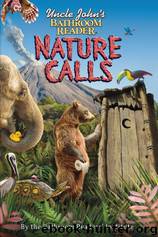Uncle John's Bathroom Reader Nature Calls by Institute Bathroom Readers'

Author:Institute, Bathroom Readers' [Institute, Bathroom Readers']
Language: eng
Format: epub
Tags: General Non-Fiction
ISBN: 9781607104285
Goodreads: 13427470
Publisher: Portable Press
Published: 2012-06-01T07:00:28+00:00
The Great Elephant Poo Poo paper company in Thailand turns elephant dung into decorative, no-smell stationery. The dung is collected from conservation parks, and some of the profits go back to the parks to protect and care for the elephants. One piece of elephant dung can produce 25 pieces of writing paper.
Mmm! Beondegi, a popular Korean snack, is boiled, salted silkworm larvae.
MYTHCONCEPTIONS
You may not have known it, but there’s a myth out there about arachnid urine. We looked into that—and some other animals myths, too.
Myth: Peonies need ants to open their flowers.
How it spread: This is a popular myth among gardeners. It spread because it’s common to see ants swarming peony buds in the morning, and before and while they’re opening.
The truth: Peonies can open just fine without ants. Ants swarm the flowers because peonies secrete a nectar that ants love to eat. (The same myth is also associated with hibiscus flowers—and it’s untrue in that case, too.)
Myth: Elephants love peanuts.
How it spread: Peanuts became a popular food in the United States in the mid-1800s, and they became a staple treat at the many circuses traveling the country at the time. Around this same time, elephants started being introduced to circuses. People walking around with bags of peanuts naturally tried to feed them to the elephants, and the elephants often ate them. So the idea spread: Elephants really like peanuts!
The truth: Elephantologists say elephants have no particular affinity for peanuts—they eat them simply because they’re offered. Elephants much prefer the foods they eat in the wild—primarily grasses, leaves, shrubs, fruit, and especially tree bark.
Myth: Camels store water in their humps.
How it spread: This myth is thousands of years old, and probably came from a simple mistaken inference made by people observing some obvious camel characteristics: 1) camels can go for a long time without drinking water—about seven days on average; 2) when they finally get water they can drink enormous amounts—up to 30 gallons in one go; and 3) they have humps. Combine these things and it’s not too hard to see how this myth came to be.
Download
This site does not store any files on its server. We only index and link to content provided by other sites. Please contact the content providers to delete copyright contents if any and email us, we'll remove relevant links or contents immediately.
| Coloring Books for Grown-Ups | Humor |
| Movies | Performing Arts |
| Pop Culture | Puzzles & Games |
| Radio | Sheet Music & Scores |
| Television | Trivia & Fun Facts |
The Infinite Retina by Robert Scoble Irena Cronin(6154)
Harry Potter and the Cursed Child: The Journey by Harry Potter Theatrical Productions(4439)
The Sports Rules Book by Human Kinetics(4288)
Molly's Game: From Hollywood's Elite to Wall Street's Billionaire Boys Club, My High-Stakes Adventure in the World of Underground Poker by Molly Bloom(3485)
A Knight of the Seven Kingdoms by George R R Martin(3187)
Quidditch Through the Ages by J.K. Rowling(3062)
How To by Randall Munroe(3031)
Flowers For Algernon by Daniel Keyes(3018)
Quidditch Through the Ages by J K Rowling & Kennilworthy Whisp(2927)
Quidditch Through the Ages by Kennilworthy Whisp by J.K. Rowling(2812)
Stacked Decks by The Rotenberg Collection(2810)
Quidditch through the Ages by J. K. Rowling(2768)
Quidditch Through The Ages by J. K. Rowling(2729)
776 Stupidest Things Ever Said by Ross Petras(2692)
Ready Player One: A Novel by Ernest Cline(2646)
What If?: Serious Scientific Answers to Absurd Hypothetical Questions by Randall Munroe(2637)
Beautiful Oblivion by Jamie McGuire(2568)
The Book of Questions: Revised and Updated by Gregory Stock Ph.d(2516)
Champions of Illusion by Susana Martinez-Conde & Stephen Macknik(2414)
